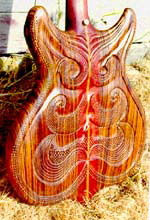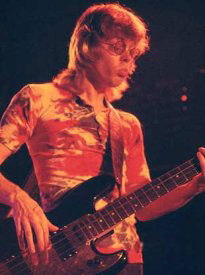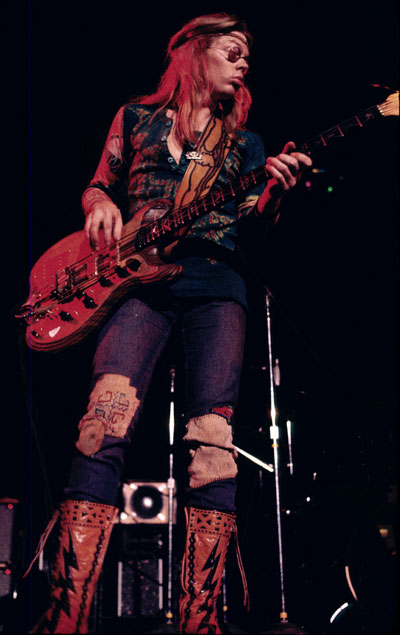Alembic
Jack Casady A friend of mine Rick Turner was making instruments. He started talking and I said you know the scales too short (on the Guild), let's make a 32 inch scale. Just make it a slab of wood and we'll do some stuff on it and we'll keep experimenting. It turned in to this project that turned in to Alembic number one. I ended up fitting a silver and brass inlay on the neck and all this carving, all kinds of exotic woods. It took about a year and a half to do and we were trying to figure out about the pickups; where I want them. I said I'm not really sure because I'd really like to experiment with where the pickups go on this. Rick said well why don't we just put them on some rails, you can slide them around all you want - see where you like it and then when you decide we'll lock them in. Well we did that and just decided to keep it that way so that I could move the pickups up and down.
It was mostly to experiment to see on my own where the sweet spots were for the pickups. Rick made many different kinds of pickups, he did the pickup winding and we did all kinds of winding and gauges. The pickups were set up so you could put them on the rails and then snap them right in with an O ring you know. It was kind of a working platform, it really wasn't meant to be a big fancy bass that it ended up. In any case we found out something detrimental about it. With the pickups being on a rail, not being set inside the bass they don't get a chance to lock in with the bass itself. So you find you gain certain things and you loose certain things when you do all of that stuff.
FlyGuitars Yes but it's good to be able to experiment like that and try different things?
Jack Casady Yeah we were interested in the science of it all.
 The reverse of Jacks Alembic #1 with it's intricate carving
The reverse of Jacks Alembic #1 with it's intricate carvingFlyGuitars And what was the conclusion?
Jack Casady I wouldn't say that Alembic bass was my favourite sounding bass at all. It certainly led me to different things. Right now I don't like putting any electronics in a bass except for the transformer I've got but I do like to run low impedance, I like to keep the electronics outside the bass. At the end of the day all your electronics if you're using preamps, you're putting your whole sound through a preamp that's run by a 9volt battery. That's what an amplifier's for.
FlyGuitars (Laughs)
Jack Casady Then it was all brand new and fun to figure out stuff that wasn't being done by a manufacturer. At the same time there was a gang of guys that was working with the PA systems. When originally we started playing out the singers were singing through inadequate systems or literally PA monitors and they all sounded like they had nasal congestion you know.
Jack Casady Until we started to say well ok let's put our own speakers up there, let's make our own sound systems. That's how Ultrasound got started and a whole bunch of companies and started working within the community. The great thing at the time in San Francisco is that there were people making posters, drawing or doing electronics or a lot of people dropping out of the aerospace industry going to just experimenting on their own. As the band started to make some money and sell some records then we could take that money and fold it back in to the experimental community to see what we could come up with to enhance the sound of the concert goer and the musicians. Now we take all that for granted cause everybody assumes you always go for good sound but that wasn't the assumption

Modulus
Jack Casady Around '78/'79 I formed a band called SVT with Brian Marnell and the first drummer was Bill Gibson. Then Paul Zahl was our drummer after Bill left to form a band called Huey Lewis And The News. Those guys were all school chums in Marin County (San Francisco), Brian Marnell and Huey Lewis and Bill Gibson and a bunch of guys. Anyway I did SVT and a couple of other projects during that period of time and had a lot of fun and it was a very inspirational and transformational time of life. I came over and played in England too with SVT.
FlyGuitars What basses were you using back then?
Jack Casady Well I went back to solid body basses in the mid to late 70's. I had a number of different ones that were patterned pretty much after a Fender Precision bass with passive electronics and I had some with extra long scale necks. I had one I think with a 35inch scale instead of 34inch. And I had started working with Jeffrey Gould who formed a company called Modulus. He started working with Graphite necks on basses to get better sustain. I had a number of his basses and a combination of forms. The one I played with SVT was a purple bass that I had done which was basically a P bass format with a little hotter pickups but passive not active circuitry.
FlyGuitars And did you do any mods to that yourself?
Jack Casady I kind of went back to a passive instrument because not only did I want to get the quality of the block of wood itself but I didn't want the footprint of the small preamps that were the necessity of the active circuitry. I found the electronic tone, first of all you couldn't hammer them, you couldn't really dig down in to them without the possibility of overdriving the preamps. Not a pleasant sound, the preamps in the bass itself run by a 9 volt battery. My objective with the earlier basses and the experimentation in the 60's was to broaden the fidelity and broaden the tonal aspects. Later on as the equipment got better in general and the sound of the equipment that was used in various clubs and halls increased in their fidelity then I felt I could go back to passive. Even though you're dealing with an electronic instrument with a passive pickup and a passive circuit you get a more purer sound in a certain way. It's a matter of your preference in the genre you're working in at the time but with SVT I found that. I liked the solid body of the instrument, and the sound I was getting with a good (Ampeg) SVT. That was a good rock sound.
FlyGuitars So how did you progress from SVT and the subsequent bands, did you use other basses before picking up the Gibson bass or was it pretty much from the Modulus you went to the Gibson?
Jack Casady I think, prior I used a couple of different basses. One had a Modulus neck, one had a wooden neck. The wooden neck was a little softer sounding, the Modulus of course the graphite was a little colder. It got a little more twang and low end and I had one bass that was a real stretcher, it was a 35 inch scale. Primarily to get that extra length on the low E string and with the round wound strings, I think I was using Rotosound for a while, it really got the good twang on the bottom.
Thanks to Graham Fieldhouse and Jack Casady. June 2010
Further reading: JackCasady.com | HotTuna.com | more bassplayer interviews

